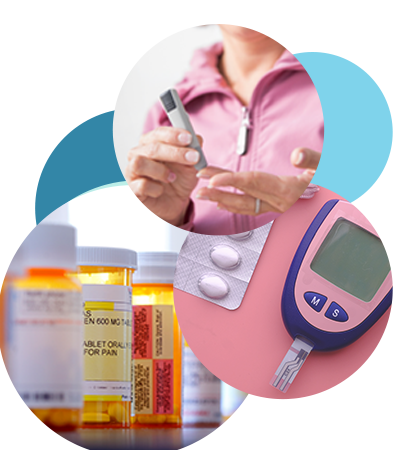Know Your Diabetes ABCs
A is for A1C test
A hemoglobin A1C test (or HBA1C ) is a blood test that measures your average blood sugar level over the past three months. When sugar enters your bloodstream, it attaches to hemoglobin, a protein in your red blood cells. The A1C test measures the percentage of your red blood cells that have sugar-coated hemoglobin. Everyone has some sugar attached to their hemoglobin, but people with higher blood sugar levels have more.
The A1C test can help you manage your diabetes by showing:
- whether a treatment plan is working
- how healthy choices make a difference in diabetes control
A1C in good control can lower your risk of heart disease, vision loss, kidney disease and other diabetes-related complications .
The blood sugar checks you do every day are different from the A1C test
These checks are also a vital tool for managing your diabetes. They can tell you whether your blood sugar levels are low, high or within your goal range.
To check your blood sugar:
- Place a small drop of blood from a fingertip onto the test strip
- Put the test strip into your glucometer
- After a few seconds, a reading will appear
Typical times to check your blood sugar include:
- When you first wake up, before you eat or drink anything
- Before a meal
- Two hours after a meal
- At bedtime
Work with your health care provider to set a blood sugar goal that is right for you. Your goal range may be different if you have other health conditions or if your blood sugar is often low or high.
Know your targets for blood sugar targets
| Recommended targets for blood sugar | My goals |
| Before meals: 80 to 130 mg/dl | to |
| 1-2 hours after meals: Below 180 mg/dl | to |
B is for Blood Pressure
blood pressure check measures the pressure of your arteries as your heart pumps. Having diabetes increases your chances of having high blood pressure. High blood pressure usually has no warning signs or symptoms. The higher your blood pressure levels, the higher the risk for other health problems such as heart disease and stroke.
It is important to check your blood pressure at every visit with your health care provider. You can also check your blood pressure with a home blood pressure monitor or at a pharmacy that has a blood pressure machine.
Blood Pressure Chart
| Category | Systolic mm Hg | and/or | Diastolic mm Hg |
|---|---|---|---|
| Normal | Less than 120 | and | Less than 80 |
| Elevated | 120 – 129 | and | Less than 80 |
| High Blood Pressure (Hypertension) Stage 1 | 130 – 139 | or | 80 – 89 |
| High Blood Pressure (Hypertension) Stage 2 | 140 or higher | or | 90 or higher |
| HYPERTENSIVE CRISIS (consult your doctor immediately) | Higher than 180 | and/or | Higher than 120 |
Work with your health care provider to set a blood pressure goal that is right for you. Your blood pressure should be under 140/90, unless your health care provider has told you differently.
C is for Cholesterol
Cholesterol is a type of blood fat-like substance made by your body. Meat and dairy food products also have cholesterol. Having high cholesterol usually has no signs or symptoms. The only way to know whether you have high cholesterol is to get your cholesterol checked.
The cholesterol test requires a simple blood draw. Be sure to ask your health care provider how to prepare for this test.
Recommended Cholesterol Levels
| Total Cholesterol | Less than 200 mg/dL |
| LDL (“bad”) cholesterol | Less than 100 mg/dL |
| HDL (“good”) cholesterol | Greater than or equal to 60 mg/dL |
| Triglycerides | Less than 150 mg/dL |
Work with your health care provider to set a cholesterol goal that is right for you. Your health care provider can tell you what your cholesterol results mean and what your goal should be.
